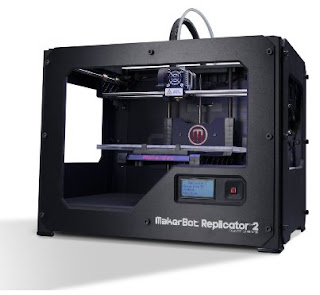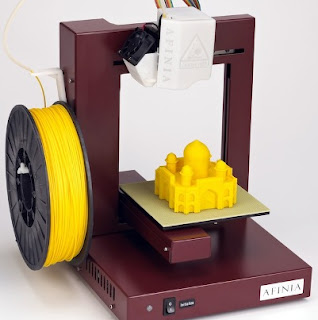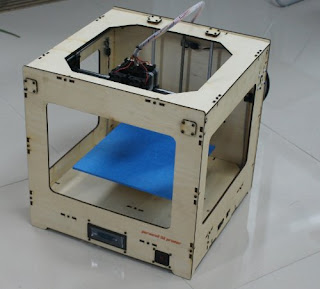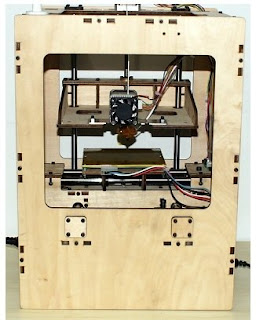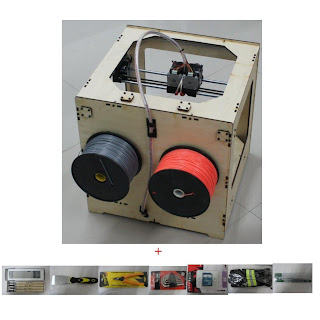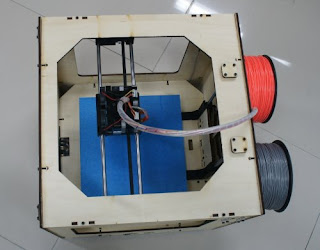Monday, June 17, 2013
Cubify Cube 3d Printer Silver (2nd Generation) Latest Version
Product Dimensions: 15 x 15 x 20 inches ; 15 pounds
Brand new Cube 3d printer by Cubify
Read more at Amazon.com
MakerBot Replicator 2 Desktop 3D Printer
- High resolution 3D printing with 0.1 mm (100 micron) layer height resolution.
- Huge 410 cubic inch build volume.
- Optimized for the renewable bio-plastic PLA, with an active cooling fan for excellent overhangs and bridges.
- FREE MakerWare software, including regular downloadble updates. Prep your 3D files for printing in seconds.
- Sturdy powder-coated steel frame for high-speed printing in any environment.
Read more at Amazon.com
Afinia 3D Printer H-Series
* Local US product support
* FCC approved
* 3D Printer ideal for rapid prototyping
* Easy and quick out-of-box setup & use
* Only $1599! * Available in burgundy color
* It is an improved UP! (major enhancements)
* Uses inexpensive ABS plastic
* Under 11 lbs, 245x260x350 mm footprint (10" x 10" x 14")
* Printing envelope over 5" cubed
This 3D printer is FCC approved and comes with local, US support.
Includes easy-to-use software, handling tools, and starter spool of 1.5 lbs ABS plastic filament. Perfect for rapid prototyping!
No mucking about, out of the box the H-Series printer is easy to setup (about 10 minutes), and easy to install using the included software for Mac or PC. Simply use the included utility to calibrate the printhead height, and within minutes you are printing!
The included software features an easy-to-use interface for laying out, orientating, duplicating, and scaling parts. It easily imports STL files, and the output can be customized in terms of the amount of support material and "raft" (base support) printed.
Breakaway support material is simple to remove, and tools for aiding the breakaway are included.
The Afinia H-Series can produce a part or model that is 5 inches cubed (i.e. 125 cubic inches) in volume. The output is accurate to within .2mm (8 thousandths of an inch), and has 30% of the strength of injection molded parts.
Design files can be created using online software, professional software such as SolidWorks, or by downloading from the extensive online community for free!
The H-Series can be operated in a standalone mode. Once the file is transferred to the device, the usb connection between the printer and computer can be disconnected - even during printing! Read more at Amazon.com
Is 3D Printing the Future for Mountain Bikes?
If you’ve been following the news out of SXSW this year you know the big story is the rise of 3D printers and scanners, bringing small-scale manufacturing to the desktop for the first time. Which got us thinking: what will this mean for mountain bikes of the future? Here are some ideas.
Get any part you need at any time
Home mechanics know this situation all too well: You just installed a new fork and you’re all ready to button everything up but realize you need a couple more spacers. Or you replace your derailleur cables and can’t find the stupid ferrules. If you had a 3D printer at home, you could just download a design file and get the exact parts you need and you could even customize them. Instead of using a stack with 3, 5, and 10mm spacers, you could print out a single spacer that’s exactly the size you need.
Even if 3D printers don’t filter down to every home mechanic, they’ll still be a boon to the local bike shop. Instead of having to stock hundreds of tiny parts or wait for special orders to come in, shops will simply have a 3D printer and access to design files directly from all the bike manufacturers. Need a derailleur hanger for your Yeti SB95? No problem, the shop will just print one out and you’ll be back in business!
With 3D printers, restoring vintage mountain bikes will be even easier. Nobody makes the part you need anymore? Find someone who has the part you need, scan it, and print out a copy. Or, design a replacement part yourself before printing.
Full article...
Is 3D Printing the Future for Mountain Bikes? | Singletracks Mountain Bike Blog
Friday, June 14, 2013
How 3D Printing Could Provide a Huge Boost to the Digital Design Industry
So, What Does this Mean for the Digital Design Industry? Well, a lot actually. Everything that is made on a 3D printer has to be designed as a digital 3D model. These digital models are designed on computers using specialist software called Computer Aided Design (CAD) software. In simplest terms; the more 3D printers are used, the more 3D designs needed. As mentioned above; it is only in the last 18 months that 3D printing has gained momentum and the attention of the public, leading to a lot of coverage in the media. This has already triggered an increase in work for digital designers and those who use CAD software. A lot of models are highly complex and detailed, and the only people who can create them digitally are highly trained specialists. But the potential of 3D printing for the design industry doesn’t necessarily stop there.
More...
How 3D Printing Could Provide a Huge Boost to the Digital Design Industry
Tuesday, June 11, 2013
How 3D printing is revolutionizing guitar-making
Guitarists of the Pete Townshend school wouldn't be impressed, but their managers would be.
The Who's pioneering instrument-smasher could find he's met his match with one of the bespoke nylon-bodied guitars made by Olaf Diegel, professor of mechatronics at Massey University in Auckland, New Zealand.
"You could throw one against the wall without worrying about it breaking," said Diegel, who will begin selling the guitars online at the end of June.
Their robustness might be music to a band manager's ears. But perhaps more notable is how Diegel makes the instruments, which are attracting interest from around the world.
Diegel is an exponent of 3D printing. His zany guitar bodies are created using computer-aided design (CAD) software, output in one piece on an EOS 3D printer. This is the new world of additive manufacturing.
Full article...
How 3D printing is revolutionising guitar-making | Technology | guardian.co.uk
Monday, June 10, 2013
MakerBot Features Next Generation Replicator 2X 3D Printer
Here at Inhabitat, we can’t get enough of 3D printers, and MakerBot’s Replicator 2 is one of the finest examples of consumer-level 3D printing. That’s why we were so excited about the release of Replicator 2X, a new, updated version of the Replicator that was unveiled this week at CES 2013. With an improved frame, ABS plastic printing and a heated build platform, the Replicator 2X will have you printing incredibly detailed, astonishingly realistic 3D models in no time from the comfort of home.
Read more: MakerBot Unveils Next-Gen Replicator 2X 3D Printer at CES 2013 | Inhabitat - Sustainable Design Innovation, Eco Architecture, Green Building | http://inhabitat.com/makerbot-updates-consumer-level-3d-printer-with-the-replicator-2x/
Wednesday, June 5, 2013
Low Price leader: JET - Open Source 3D printer
JET - Open Source 3D printer - ReplicatorG - Dual Extruder Head
Product Features
- Pure open source 3D printer. Use ReplicatorG control software (http://replicat.org/).
- Simple user interface. Simple but solid hardware structure. Robust design.
- Easy to use for hobbyists and beginners. Flexible to learn, play and create.
- Enjoy 3D printing. Play 3D printing. Safe to dissemble and assemble.
- Top brand and top quality. Satisfaction guaranteed.
- Compatible with most 3D Printers such as RepRap, Makertbot, Ultimaker, Up!, Makergear, etc.
Read more at Amazon.com
Tuesday, June 4, 2013
3D Printer Round-Up - Up! Mini, Solidoodle 2, Cube 3D
Published on Dec 19, 2012. It all started back in 2007 when the first RepRap machine was built. The idea behind RepRap was to design a machine that could build complex parts in three dimensions using extruded molten plastic and that machine could also "self-replicate" or build itself a new machine. Since then 3D printers from all walks of life have emerged from the community, so we decided to reach out to a few of the more prominent names in 3D printing and do our usual round-up two step with them. Stay with us as we walk through some of the latest 3D printers in action, from Solidoodle with the Solidoodle 2, PP3DP with their Up! Mini, and 3D Systems the godfather of STL, with their Cube 3D.
3D Printable Textiles - Eco-Friendly Printable Clothing is Like Modern Chain Mail
The fabric is seamless and flexible, conforming to the contours of skin. The fabrics above look almost medieval, like a suit of chain mail, but if they have the ability to transform into different styles, this 3D printable textiles eco-friendly alternative may really take off.
Full article...
3D Printable Textiles - Eco-Friendly Printable Clothing is Like Modern Chain Mail (VIDEO)
100 Ingenious 3D Printer Pieces
 Since the invention of the 3D printer, people have been able to physically create anything they can possibly imagine.
Since the invention of the 3D printer, people have been able to physically create anything they can possibly imagine.
Now that dimensional printing has become more accessible to the public, industries and private businesses all over the world are changing. With the ability to manufacture any product you want to the exact specifications you need, you no longer have to go to a third party to find or make a certain item for you. The health industry, the military and even Etsy sellers have all found the benefits of creating their own customized components quickly and affordably.
With creation possibilities including home decor, vehicle parts, apparel, architecture and food available at the click of a button, the 3D printer has changed the world of manufacturing and consumerism forever.
Full article...
100 Ingenious 3D Printer Pieces - From 3D Printed Pasta to Instantaneous 3D Photography (TOPLIST)
How 3-D Printing Will Turn Homes Into Mini Factories
The changes that will enable this tranformation are happening already. Presently, home printers fab in plastic, as Hull’s machine did. But industrial printers have evolved to print a multitude of materials, from glass to stone. Printer maker Objet has released the Connex500, a $250,000 printer that works in 14 polymers at once.
Researchers at the Cornell University Creative Machines Lab recently developed a machine that they used to print components vital to working electronics, as well as a functioning electromagnet and battery. Home printers are poised to follow a similar development curve. Hod Lipson, the Creative Machines Lab director, says consumer-grade multi-material printers are less than a decade away.
Rather than fab a plastic lamp shade, makers will print the components of the entire lamp.
Just as the capability of printers is growing, so is the ecosystem of 3-D designs and design tools, making it easier and easier to print at home. At Thingiverse, makers can scour a database of thousands of downloadable designs. Autodesk design software converts digital snapshots of real-life objects into 3-D patterns. And Adobe is developing a program that evaluates designs for structural flaws before they are printed.
Alone, such advancements will turn home printing from a novelty to a necessity. (Rather than fab a plastic lamp shade, makers will print the components of the entire lamp, wiring, plug, and all.) But truly transformative change will come from another industry: recycling. Beginning in the 1970s, machines at recycling centers have ground discarded plastic into raw material that companies use to make everything from toys to carpeting.
Similar processes exist for metal and glass. In January, Tyler McNaney, a student at Vermont Technical College, debuted the Filabot, a machine that repurposes plastic at home. The tabletop device grinds and melts most recyclable plastic into the raw filament used in 3-D printers. If devices like Filabot succeed, makers will not only produce new objects in their workshops, but also repurpose old ones.
Original Article
How 3-D Printing Will Turn Homes Into Mini Factories | Popular Science
Subscribe to:
Posts (Atom)

